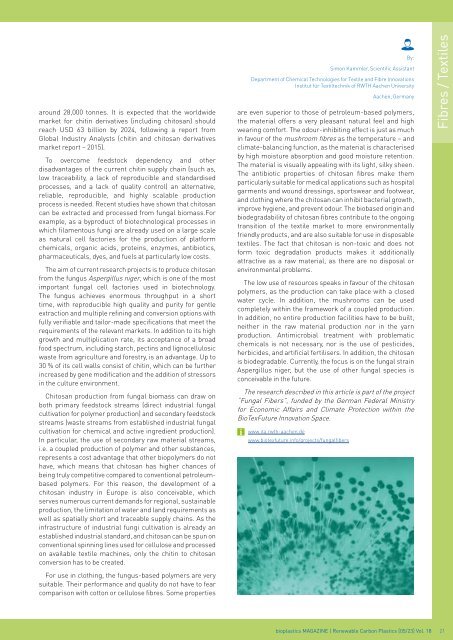Issue 05/2023
Highlights Fibres / Textiles Polyurethane / Elastomers
Highlights
Fibres / Textiles
Polyurethane / Elastomers
Create successful ePaper yourself
Turn your PDF publications into a flip-book with our unique Google optimized e-Paper software.
around 28,000 tonnes. It is expected that the worldwide<br />
market for chitin derivatives (including chitosan) should<br />
reach USD 63 billion by 2024, following a report from<br />
Global Industry Analysts (chitin and chitosan derivatives<br />
market report – 2015).<br />
To overcome feedstock dependency and other<br />
disadvantages of the current chitin supply chain (such as,<br />
low traceability, a lack of reproducible and standardised<br />
processes, and a lack of quality control) an alternative,<br />
reliable, reproducible, and highly scalable production<br />
process is needed. Recent studies have shown that chitosan<br />
can be extracted and processed from fungal biomass.For<br />
example, as a byproduct of biotechnological processes in<br />
which filamentous fungi are already used on a large scale<br />
as natural cell factories for the production of platform<br />
chemicals, organic acids, proteins, enzymes, antibiotics,<br />
pharmaceuticals, dyes, and fuels at particularly low costs.<br />
The aim of current research projects is to produce chitosan<br />
from the fungus Aspergillus niger, which is one of the most<br />
important fungal cell factories used in biotechnology.<br />
The fungus achieves enormous throughput in a short<br />
time, with reproducible high quality and purity for gentle<br />
extraction and multiple refining and conversion options with<br />
fully verifiable and tailor-made specifications that meet the<br />
requirements of the relevant markets. In addition to its high<br />
growth and multiplication rate, its acceptance of a broad<br />
food spectrum, including starch, pectins and lignocellulosic<br />
waste from agriculture and forestry, is an advantage. Up to<br />
30 % of its cell walls consist of chitin, which can be further<br />
increased by gene modification and the addition of stressors<br />
in the culture environment.<br />
Chitosan production from fungal biomass can draw on<br />
both primary feedstock streams (direct industrial fungal<br />
cultivation for polymer production) and secondary feedstock<br />
streams (waste streams from established industrial fungal<br />
cultivation for chemical and active ingredient production).<br />
In particular, the use of secondary raw material streams,<br />
i.e. a coupled production of polymer and other substances,<br />
represents a cost advantage that other biopolymers do not<br />
have, which means that chitosan has higher chances of<br />
being truly competitive compared to conventional petroleumbased<br />
polymers. For this reason, the development of a<br />
chitosan industry in Europe is also conceivable, which<br />
serves numerous current demands for regional, sustainable<br />
production, the limitation of water and land requirements as<br />
well as spatially short and traceable supply chains. As the<br />
infrastructure of industrial fungi cultivation is already an<br />
established industrial standard, and chitosan can be spun on<br />
conventional spinning lines used for cellulose and processed<br />
on available textile machines, only the chitin to chitosan<br />
conversion has to be created.<br />
For use in clothing, the fungus-based polymers are very<br />
suitable. Their performance and quality do not have to fear<br />
comparison with cotton or cellulose fibres. Some properties<br />
By:<br />
Simon Kammler, Scientific Assistant<br />
Department of Chemical Technologies for Textile and Fibre Innovations<br />
Institut für Textiltechnik of RWTH Aachen University<br />
Aachen, Germany<br />
are even superior to those of petroleum-based polymers,<br />
the material offers a very pleasant natural feel and high<br />
wearing comfort. The odour-inhibiting effect is just as much<br />
in favour of the mushroom fibres as the temperature – and<br />
climate-balancing function, as the material is characterised<br />
by high moisture absorption and good moisture retention.<br />
The material is visually appealing with its light, silky sheen.<br />
The antibiotic properties of chitosan fibres make them<br />
particularly suitable for medical applications such as hospital<br />
garments and wound dressings, sportswear and footwear,<br />
and clothing where the chitosan can inhibit bacterial growth,<br />
improve hygiene, and prevent odour. The biobased origin and<br />
biodegradability of chitosan fibres contribute to the ongoing<br />
transition of the textile market to more environmentally<br />
friendly products, and are also suitable for use in disposable<br />
textiles. The fact that chitosan is non-toxic and does not<br />
form toxic degradation products makes it additionally<br />
attractive as a raw material, as there are no disposal or<br />
environmental problems.<br />
The low use of resources speaks in favour of the chitosan<br />
polymers, as the production can take place with a closed<br />
water cycle. In addition, the mushrooms can be used<br />
completely within the framework of a coupled production.<br />
In addition, no entire production facilities have to be built,<br />
neither in the raw material production nor in the yarn<br />
production. Antimicrobial treatment with problematic<br />
chemicals is not necessary, nor is the use of pesticides,<br />
herbicides, and artificial fertilisers. In addition, the chitosan<br />
is biodegradable. Currently, the focus is on the fungal strain<br />
Aspergillus niger, but the use of other fungal species is<br />
conceivable in the future.<br />
The research described in this article is part of the project<br />
“Fungal Fibers”, funded by the German Federal Ministry<br />
for Economic Affairs and Climate Protection within the<br />
BioTexFuture Innovation Space.<br />
www.ita.rwth-aachen.de<br />
www.biotexfuture.info/projects/fungalfibers<br />
Fibres / Textiles<br />
bioplastics MAGAZINE | Renewable Carbon Plastics [<strong>05</strong>/23] Vol. 18<br />
21

















